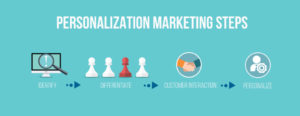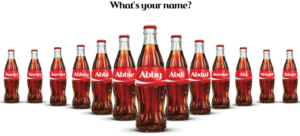
20 Sep Understanding Personalized Marketing Strategy
“Pay attention and adapt your style to that of your prospect and customer. I work with great salespeople and the most successful know how to connect with a variety of buyers.” – Colleen Stanley
Have you ever wondered how your favorite online shops come up with this-is-exactly-what-I-like recommended products? Have you ever been fascinated on how your most visited websites generate advertisements containing your recent searched products? Does it scare you or do you find it helpful?
Welcome to the world of personalization marketing strategy! In this article, we will discuss what happens in the realm of personalized marketing, how it uses analyzed data from consumers’ preferences and its positive impact on companies and businesses nowadays.
What is Personalized Marketing Strategy
Personalized marketing, which is also known as one-to-one marketing, is a marketing strategy that focuses on knowing customer’s individual needs and preferences and tailor fits these gathered data in creating customized individual marketing messages. This strategy is used to improve customers’ experience with the company while keeping current and prospective customers continually engaged with the company’s business. (source)
How Does Personalized Marketing Work
Now let’s figure out how personalized marketing works. The company must exert an effort on data gathering to achieve rewarding personalized marketing effects. This can be done with the help of existing data extraction software available online. The data extracted are then automatically processed to obtain personal information from web pages in relation to the nature of the business, be it in healthcare, sales, services, and such. Data gathered are then analyzed and leveraged in order to produce personalized marketing content to individual customers. The diagram below best illustrates the process of how personalized marketing works.
First, identify the customers. This is where the collection of any available personal data happens – not just the name, mobile number, email address or any contact information of the customer, but also the behavior, the preferences, the habits, and the like. The customer’s actions, choices, and interaction with the company’s website are studied and analyzed by the data extracting software in order to create a suitable profile that will be used to accurately predict and match the individual customer’s needs.
Second, differentiate the customer. Every individual has different traits and personalities. The differences they have correlates to how varied their preferences are — whether in products or in services. The company, therefore, processes a collective effort to provide a relevant message per individual according to the analyzed data after the first step.
Third, interact with the customer. This time, the collated personalized data of the customer is used in the communication process. The company interacts and communicates with the customer or the prospective customer using the acquired information after doing the first two steps. This is to provide personalized offers that best fit the individual needs. All communication from the start of the customer’s interaction with the company until the present should be accounted for, be it two months ago, a week ago, or even just last night. Every information is essential in seeing a better picture of the customer’s value and needs.
Lastly, personalization comes. The collective effort of the company should not end only in knowing who their customer is. With all the data gathered above, the company then modifies some of its strategies to address and conform the needs of the customer. The company’s efforts will be reflected on how well they now know their customers. Relevant, timely and usable information is then given to the customer based on the persona conceived after all the process above. Therefore, the ultimate goal is to create a personalized offer to the customer so that he/she will most likely avail the products or services.
(source)
Effective Personalized Marketing Strategies
The Personal Touch – Nothing beats a customer service where personal attention and the feeling of importance is relayed accordingly to the customer. This strategy takes into consideration the habits, usual preferences and transaction history of the customer with the company. Customers feel important and valued if previous choices are remembered and accounted for. It’s like knowing the person’s personality traits as well as likes and dislikes and using this knowledge in providing a personalized output. A good example is a barista who knows well what coffee to prepare just by the sight of the customer reaching for the coffee shop’s door. (source)
Personalized Recommendation – Most companies are now using this strategy to recommend personalized products or services to their customers. They use the collected analyzed data per individual in creating suggestions that best suit the needs and preferences of the customers. They leverage the data on customer’s patterns and transaction history in generating suggestions and recommendations that conform per customer.
Maximizing Social Media Impacts – Many people are using social media platforms like Facebook, Twitter, Instagram, and Pinterest. These channels make way for marketing personalization effectively. Sharing information and day to day ventures have become a trend today and this is not just true among Millennials, but also with Generation X and Baby Boomers. According to SproutSocial’s study, Gen X and Millennials are twice as much likely to follow brands on social media as Baby Boomers do. Consumers want suggestions and recommendations that are relevant, specialized, unique and perfectly fit their desires. Maximizing the data shared in Social Media helps the company in gaining insights of who their customers are and what brands and shopping sites are they likely to engage with. The more information is gathered, the better understanding the company gains which is fundamental in creating personalized messages for consumers.
Why use Personalized Marketing Strategy
Personalized marketing strategy has brought great positive impact on companies. Statistics wise, it is said by Infosys in their efforts on gaining shopping preference insights from 1,000 consumers and 50 retailers across the United States that:
- 86% said that personalization has at least some impact on what they purchase, and 25% say personalization significantly influences what they purchase
- 59% of shoppers who have experienced personalization believe it has a noticeable influence on purchasing
Also, based on a 2016 study from Accenture, 65% of consumers are more very probably to buy products online or in a store if the previous purchase transactions are remembered. This data was gathered from more than 1,500 consumers across the United States and the United Kingdom between the ages 18 and 60. Their preferences and online shopping behavior were studied.
Some of the Best Examples of Effective Personalized Marketing That Went Viral
- Coca-Cola – In 2014, the company launched the “Share a Coke” campaign in the U.S.; the campaign was also previously launched in Australia in 2011. That year, Coca-Cola personalized it’s marketing campaign and targeted the teens and millennials by featuring 250 common names and phrases on its packaging. This has brought a positive turn-around change to the company’s 10-year sales decline. Examples of the names printed on their packaging were Kylie, Luke, Bobby, Angel, Chloe, Dad and much more. Examples of phrases used are “It’s a beautiful life”, “Always on my mind”, “Put a little love in your heart” and such. The “Share a Coke” campaign aroused excitement to the targeted population in a personalized way.
- Spotify – Last year, Spotify commenced its data-driven campaign – “Thanks, 2016. It’s Been Weird” which started from the company’s end of 2015 campaign – “Year in Music”. This big data-driven global campaign of Spotify caught attention and brought laughter and smile to so many people. Spotify gathered data from listeners globally and strategically used this data in relating to its listeners emotionally. Just like the billboard posted below which says “Dear person in the Theater District who listened to the Hamilton Soundtrack 5,276 times this year, can you get us tickets?”, it took personalized marketing to another level. Other examples are “To the 1,235 guys who loved the Girls’ Night playlist this year, we love you.”, “Dear person in LA who listened to the Forever Alone playlist for 4 hours on Valentine’s Day, you OK?” and much more.
Dear person who played “Sorry” 42 times on Valentine’s Day, what did you do?
Want to improve your digital marketing strategy, subscribe to Norse Sound Creative Online Marketing where content creation, search engine optimization (SEO), social media management, or creation of local listings are packaged specifically for your company’s growth.






No Comments